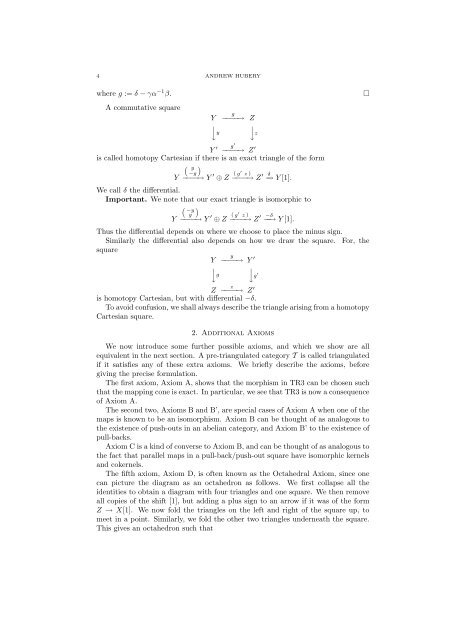NOTES ON THE OCTAHEDRAL AXIOM 1. Pre-Triangulated ...
NOTES ON THE OCTAHEDRAL AXIOM 1. Pre-Triangulated ...
NOTES ON THE OCTAHEDRAL AXIOM 1. Pre-Triangulated ...
You also want an ePaper? Increase the reach of your titles
YUMPU automatically turns print PDFs into web optimized ePapers that Google loves.
4 ANDREW HUBERYwhere g := δ − γα −1 β.A commutative squaregY −−−−→ Z⏐⏐ ⏐↓↓ yzY ′ g−−−−→ ′Z ′is called homotopy Cartesian if there is an exact triangle of the formY“ y−g”−−−−→ Y ′ ⊕ Z ( g′ z )−−−−→ Z ′ δ−→ Y [1].We call δ the differential.Important. We note that our exact triangle is isomorphic to“ ” −ygY −−−−→ Y ′ ⊕ Z ( g′ z )−−−−→ Z ′ −δ−−→ Y [1].Thus the differential depends on where we choose to place the minus sign.Similarly the differential also depends on how we draw the square. For, thesquareyY −−−−→ Y ′⏐⏐ ⏐↓g↓ g ′zZ −−−−→ Z ′is homotopy Cartesian, but with differential −δ.To avoid confusion, we shall always describe the triangle arising from a homotopyCartesian square.2. Additional AxiomsWe now introduce some further possible axioms, and which we show are allequivalent in the next section. A pre-triangulated category T is called triangulatedif it satisfies any of these extra axioms. We briefly describe the axioms, beforegiving the precise formulation.The first axiom, Axiom A, shows that the morphism in TR3 can be chosen suchthat the mapping cone is exact. In particular, we see that TR3 is now a consequenceof Axiom A.The second two, Axioms B and B’, are special cases of Axiom A when one of themaps is known to be an isomorphism. Axiom B can be thought of as analogous tothe existence of push-outs in an abelian category, and Axiom B’ to the existence ofpull-backs.Axiom C is a kind of converse to Axiom B, and can be thought of as analogous tothe fact that parallel maps in a pull-back/push-out square have isomorphic kernelsand cokernels.The fifth axiom, Axiom D, is often known as the Octahedral Axiom, since onecan picture the diagram as an octahedron as follows. We first collapse all theidentities to obtain a diagram with four triangles and one square. We then removeall copies of the shift [1], but adding a plus sign to an arrow if it was of the formZ → X[1]. We now fold the triangles on the left and right of the square up, tomeet in a point. Similarly, we fold the other two triangles underneath the square.This gives an octahedron such that□
















